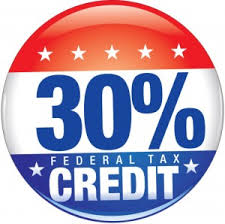Taxpayers that made any energy saving improvements to their home in 2018-2021, could be eligible for a credit of up to 30% of equipment and installation costs. The credit is 30% for tax years 2018 and 2019, 26% for tax year 2020 and declines to 22% for tax year 2021. The nonbusiness energy property credit applies to improvements made on personal residents, and in many cases, apply to second homes within the United States. This credit does not apply to rental properties (however, can claim a solar credit on commercial rental property and residential rental property under Form 3468 Investment Credit, see Business Energy Investment Tax Credit blog)
There is no limit on the amount of the credit for solar, wind and geothermal equipment explained below, but the maximum tax credit for fuel cells is $500 for each half-kilowatt of power capacity. For example, a fuel cell with a 2-kilowatt capacity would qualify for 4 x $500 = $2,000 tax credit.
The following are improvements to primary or secondary residences that may qualify for the Renewable Energy Credit:
Qualified solar electric property costs: These are costs for property that uses solar energy to generate electricity which must be used in your home, including solar panels or photovoltaic systems.
Qualified solar water heating property costs: These are costs used to purchase and install solar powered water heaters. In order to qualify for the credit, the water heated by the property must be used inside the home, and at least half of the home’s water-heating capacity must be solar. Solar powered water heaters used to heat water for swimming pools and hot tubs do not qualify. The manufacturer should be able to let you know if the system is certified by a solar rating certification in the state installed in order to qualify for the credit.
Qualified small wind energy property costs: These are costs for property that use wind turbines that generate electricity for use in your home. The wind turbines should generate up to 100 kilowatts of electricity for residential use.
Qualified geothermal heat pump property costs: These are costs for property that use ground or a ground water thermal energy source to heat your home or as a thermal energy sink to cool your home. The property must meet all the federal Energy Star guidelines in order to qualify for the credit. The manufacturer of the product should be able to let you know if the qualified property being installed meets these guidelines.
Qualified fuel cell property costs: These are costs for property that use fuel stack assemblies with certain plant components converting fuel into electricity. Fuel cells that rely on a renewable resource (for example, hydrogen) to generate power for a home are also included, however the equipment must generate at least 0.5 kilowatts of power. The system must be installed in connection with your main home only, second homes do not qualify.
Nonbusiness Energy Property Tax Credit (Expired December 31, 2017)
Unfortunately, the nonbusiness energy property tax credit expired December 31, 2017. The credit originally allowed taxpayers to take a credit of 10% of “qualified energy efficiency improvements” and 100% of “residential energy property costs” for tax years 2009-2017 as long as the equipment and materials related to energy efficiency met certain standards set by the Department of Energy. However, there are significant limits placed on this credit, including a maximum of $500 for years 2006 to 2017. Of the $500 limit, $200 can be for windows, $50 for a furnace circulating fan, $150 for a furnace or boiler, and any other single property cost is limited to $300.
“Qualified energy efficiency improvements,” include improvements such as home insulation, exterior doors, exterior windows and skylights and certain roofing materials.
“Residential energy property costs” include electric heat pumps, electric heat pump water heaters, central air conditioning systems, natural gas, propane or oil water heaters, stoves that use biomass fuel, natural gas, propane or oil furnaces and oil hot water boilers, and advanced circulating fans for natural gas, propane or oil furnaces.
Although this credit is expired, if you made any energy improvements from 2009-2017 and have not filed your taxes for those years, or did not claim the credit, you may still claim the credit when you file or amend the previously filed return.


